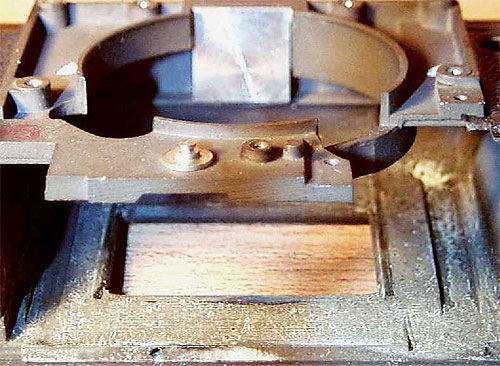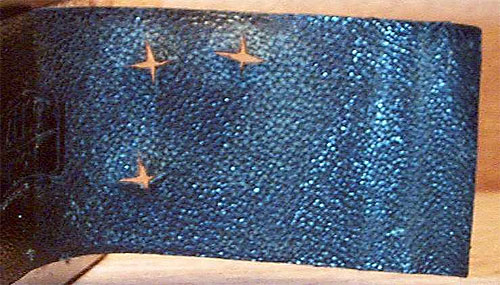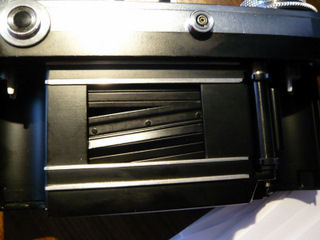Zeiss Ikon Contax Camera Repair
A home for your Zeiss Ikon Contax, Contarex or Super Ikonta camera!
Information
- Services
- Scheduling Services
- Waiting List Info
- Guarantee
- What is a CLA?
- What a CLA leaves out
- Purchasing a Contax Camera?
- Camera Equipment Sales
Cameras Serviced & Pricing
- Contaflex TLR
- Contarex Bullseye
- Contax I
- Contax II and III
- Contax IIa and IIIa
- Zeiss Lenses
- Kiev Cameras
- Contaflex SLR
- Kyocera Contax
Overhauls
What is a CLA?
I know this is hard to believe, but there is no industry standard or specification of any kind that sets out what a CLA is supposed to be or consist of. The acronmy "CLA" means, clean lubricate and adjust, but it is more of a question than an answer. The question is clean what and how, lubricate with what and how, and adjust what? The answers will vary from shop to shop and from person to person and to sum it all up from my experience CLA means "as little work as possible" for as much money as possible.
This is a picture of the inside of the body shell of a Contax IIa camera as it was when it was first opened here. The white deposit that is visible coating the insides and forming a little ball in the upper right hand corner is mold. The inside of many old Contax cameras is coated with mold and bacteria as thickly as is this one. If the CLA you obtain for your camera does not specifically include a body shell cleaning the body shell will not be cleaned and this is what you are going to be putting up against your face. If you are allergic or if you can develop an allergy, handling a camera such as this is one sure way to stimulate an attack of hives, hay fever or asthma:

The following picture sums up my experience with what CLA really means. It is of the aperture control ring of a Contax Carl Zeiss 50 mm f 2.0 Sonnar lens that has been removed from its lens mount. As you can see it is fility dirty below the area which would be visible when the lens is assembled. This dirt is fifty years accumulation of finger oil, aperture control grease and dirt. The rest of the interior of the lens is in the same condition and this explains the stickiness of the aperture control feel.

This lens was sent to a person in the camera industry whose reputation is so great I will not mention it for obvious reasons. He performed a CLA on this lens and returned it to its owner. The owner contacted me to ask if I could correct the stickiness of the aperture control feel. You can see for yourself what I found when I disassembled this lens. The only work performed that constituted a complete CLA for this lens was to clean the visible oil off of the aperture blades and wipe off the visible exterior parts. The rest of the lens was left filthy dirty and this includes the lens elements themselves which had the start of mold growth. There is nothing exceptional in this. It is depressingly normal.
Here's another CLA nightmare. It's a picture of what remains after the pure camera butchery of the normally practised procedure for Zeiss bump removal:

You can see how the perfectly good back leather over the bumps has been cut so that the bump material can be removed. This not only ruins the back leather and cuts the market value of the camera body in half, it is totally useless. The bump material reforms and when it does the cuts split open. It only takes a short while for the bump matieral to start to grow back.
A long term consequence of a normal CLA is severe damage to the shutter. The perforance and reliability of the high speeds is totally dependent upon the minimization of friction in the entire shuter mecanism. This means that for the high speeds to work properly all the parts must be cleaned of old sticky grease deposits and then properly lubricated. During a normal CLA what is done to avoid all this extra work is to merely tighten up the shutter curtain sprngs. But the shutter slats are made of thin and fragile aluminum and they tend to stretch; and the shutter tapes tend to fray and then break under the excess tension. This picture shows the final result of a normal CLA:

This is a picture sent to me by a good customer who bought a camera on the Internet and then did not have it checked here. He used it for about three years and then, when it finally failed, got in touch. There are no spare parts available. This camera needs a new shutter and it can only come from a parts donor body. This is going to be an extremely expensive repair. While it might appear all it needs is new tapes, the curtains have been stretched and also must be replaced.

This is a set of shutter springs from a Contax IIa/IIIa. During a regular overhaul performed here they are hand cleaned to remove all old sticky deteriorated grease, then ultrasonically cleaned to remove corrosion and so they will accept new lubricant. Then they are treated immediately with watch oil and finally the springs are coated with Swiss made watchmakers spring grease. This ensures that the camera will perform to its highest level of performance at the 1/1250 speed for many decades to come. You don't get this with a CLA and yes, it is necessary.
So here's the long and short of it. CLA usually means that you have been robbed and your camera has been set up for a very expensive repair. I have yet to see a camera that has supposedly had a CLA which has actually been cleaned and lubricated. All have been dirty and full of old hardened grease, dirt and metal wear products. Some have been "adjusted", and adjusted is not the right word because it does not mean "full of bent parts".
The main problem I see with cameras that are sent to me that are not performing properly after having had a CLA is that when I open the camera it is apparent that absolutely nothing of any substance has been done to the camera. I have yet to open a camera that has had a CLA that is not filthy dirty inside with the parts either not lubricated or covered with ancient hardened lubricant. In some cases I have seen cameras that have been lubricated, but the lubricant was uselessly applied on top of parts instead of underneath them where it should have been applied.
If you do send your camera to someone for a CLA, and you are fortunate enough to really get one you should understand what a CLA really is. If it is an "honest" CLA, and I've never yet seen one of these, it is a very superficial camera service that is appropriate only for a camera that is in otherwise full functioning condition and which has been regularly receiving "honest" CLA's on a frequency of no less than 5 years throughout its life. In the old days when people could afford to purchase mechanical watches everyone knew it was necessary to have the watch cleaned, lubricated and adjusted every three to five years. This wisdom was also well known among camera owners because of the similarity between watches and mechanical cameras. But this knowledge is not so wide spread today.
I don't do CLA's on anything. All that is available from me are complete disassembly overhauls. This is the only way to restore an 85 to 50 year old camera or lens to like new consistency, accuracy and reliablity. It is the only way to give you want you want in a camera. It is the only way for me to give you your honest dollars worth.
Overhauls
Here's what an overhaul consists of:
- Complete camera disassembly;
- Ultrasonic cleaning of all mechanical parts and screws;
- Complete internal and external camera shell cleaning;
- Cleaning and lubrication of all film advance system components;
- Adjustment of poorly fitting original parts;
- Cleaning of all optical surfaces in the camera body;
- Leather cleaning, preservation and resurfacing;
- Collimator check and precision alignment of the lens;
- Autocollimator check of lens mount alignment;
- Self timer cleaning and lubrication;
- Renewal of all lubricants in the camera using modern non deteriorating synthetic lubricants;
- Diamond lapping of focusing helical to restore smoothness and ease of rotation;
- Recementing of range finder lenses;
- And repair of broken parts among other things.
All of these elements are part of a regular overhaul as I provide it. They are all necessary. The majority of Contax cameras sent to me for servicing are not in a condition where even an honest CLA is appropriate. Many of the cameras I receive are sent by people who have recently attempted to have their camera returned to normal working condition with a CLA only to have the costly experiment be a failure.
It is a sad fact that an attempt to restore a Contax camera that has not been used for ten or more years by a normal CLA may result in serious damage to internal components. The reason for this is that unskilled workers will many times attempt to restore a sticky shutter whose real problem is hardened lubricant to normal operation by taking adjustments beyond the limit of adjustment. This can result in permanent damage to shutter components.
It is also a sad fact that continued use of an old Contax without a complete servicing can result in permanent damage to precision shutter components due to lack of lubrication. It doesn't take too many rolls of film through an old Contax with hardened lubrication to permanently damage shutter components so that the highest shutter speeds can never be restored.
